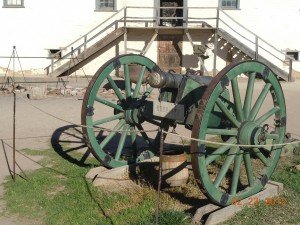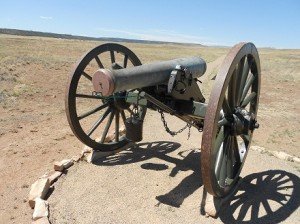
The Mountain Howitzer was one of the most effective weapons employed by the U.S. Army Cavalry during the latter part of the 1800’s. The Mountain Howitzer was essentially a compact cannon that could easily be taken along by cavalry units on the field. Ironically, it was the Mountain Howitzer that was not taken along by George Armstrong Custer during the Sioux War of 1876. If he had not declined bringing along this weapon the history books may have been written differently. The Mountain Howitzer’s compact size and portability was ideal for such cavalry expeditions.
The Mountain Howitzer was built in several styles, with the 12 pound gun probably the most used in the frontier west. Being first designed in Sweden during the latter 17th century, the practical utility of this weapon goes back to Europe and the Peninsular War when the Spaniards used these weapons against Napoleon. That war began in 1808 and ened with Napoleon’s defeat in 1814.
You’ll also enjoy our article and photos of Military Cannons used at our old west coast forts.

In America, the Mountain Howitzer saw action in the Mexican-American War, the Civil War and during the various western Indian wars. The Mountain Howitzer got it’s name because the original cannons were taken apart for transport into the mountains and then reassembled when needed. The weapons were designed to be portable. The twelve pound designation means that the cannon shot a twelve pound cannon ball.The Mountain Howitzers were often referred to as “Bull Pups”. The barrel was 38 inches long with a 4.62 bore. These small yet powerful cannons had a range of from about 900 to 1,000 yards.The first models were made in bronze. The later models of the howitzer were affixed to small carriages and these could be pulled along by horse or mule with little trouble.
An interesting story comes from the two Mountain Howitzers on display in Old Town Albuquerque’s plaza. The howitzer’s made there way to Albuquerque during the Civil War when the confederates made a push north into New Mexico. At one time, the Confederates occupied Albuquerque on their way further north. Their advance was stopped at the historic Battle of Glorieta Pass just to the east of Santa Fe. There are two Mountain Howitzers located on the plaza in Old Town Albuquerque just a few miles west of the modern downtown location. These are exact replicas of the cannons that were in place there during the Confederate occupation in 1862.

The Howitzer barrels were buried when the Confederates retreated. In 1889 all eight barrels that were buried were unearthed when an officer returned to the site and showed where they had been buried. Because of the great historical value of these eight barrels they were eventually place in the Albuquerque Museum of Art and History which is located only three blocks northeast of the Old Town plaza. The museum is a great addition to a trip planner for anyone visiting or vacationing in Albuquerque. The exact replica Mountain Howitzers on the plaza today are mounted on “Prairie” gun carriages which were thought to be the type utilized by the Confederate troops.
You may be interested in these related articles…The California State Military Museum and a Tour of Sutter’s Fort in Sacramento.
When you travel around the United States you’ll have plenty of opportunities to see these historic Mountain Howitzer cannons at many locations. In addition to the cannons located on the Albuquerque Old Town plaza is an authentic Mountain Howitzer on the grounds of the Fort Union National Monument in northern New Mexico between Raton and Las Vegas. You’ll also see a Mountain Howitzer on display at the Fort George G. Meade Museum in Maryland, Sutters Fort in Sacramento California, Fort Sill Oklahoma, the Sheldon Prairie Museum in Sheldon Iowa, Fort Laramie in Wyoming, Fort Concho in San Angelo Texas and at many other historic sites and old military forts.
